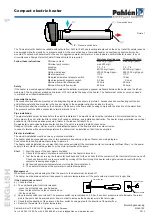
©2017 Pinnacle Climate Technologies
8
Vent-Free Gas Heater User’s Manual
Preparing for Installation
WATER VAPOR IS A BY-PRODUCT OF UNVENTED ROOM HEATERS
Gas combustion creates water vapor as a by-product. Unvented room heaters create about one (1) ounce (30
ml) of water for every 1,000 BTUs (0.3 kW) of gas input per hour. An unvented room heater is recommended
as a supplemental heat source for a single room rather than as a primary heat source for an entire house. The
water vapor does not typically create a problem. In most cases, the water vapor enhances the low humidity
conditions that are typical of cold weather.
Keep these points in mind so that the water vapor does not create a problem:
• The heater must be the proper size for the application. Provide adequate combustion air and circulation air.
• In humid environments, use a dehumidifier to help lower the amount of water vapor in the air.
• Do not use an unvented room heater as your primary heat source.
AIR FOR COMBUSTION AND VENTILATION
This heater shall not be installed in a room or space unless the required volume of indoor combustion air is
provided by the method described in the
National Fuel Gas Code, ANS Z223.1/NFPA 54
, the
International Fuel
Gas Code
, or applicable local codes.
PRODUCING ADEQUATE VENTILATION
Spaces in homes can be divided into these ventilation classifications:
• Unusually Tight Construction
• Unconfined Space
• Confined Space
The information on pages
8–10
will help you classify your space and provide adequate ventilation.
Confined and Unconfined Space:
A confined space has a volume less than 50 cu. ft. per 1,000 BTU/hr (4.8 m
3
per kW) of the total input rating
of all appliances installed in that space. An unconfined space has a volume not less than 50 cu. ft. per 1,000
BTU/hr (4.8 m
3
per kW) of the total input rating of all appliances installed in that space. Rooms that are
directly connected to the space in which the appliances are installed*, through openings that do not have
doors, are considered a part of the unconfined space.
Do not install this heater in a confined space or unusually tight construction unless you provide provisions
for adequate combustion and ventilation air.
*Adjoining rooms are directly connected only if there are doorless passageways or ventilation grills between them.
Unusually Tight Construction:
Doors and windows may leak air that provides enough fresh air for combustion and ventilation. However,
you must provide additional fresh air in buildings of unusually tight construction. Unusually tight
construction is defined as construction that meets the following criteria:
A. Walls and ceilings exposed to the outside atmosphere have a continuous water vapor retarder with a
rating of one perm (6x10-11kg per pa-sec-m2) or less with openings that are gasketed or sealed.
B. Doors and windows that can be opened have weather stripping.
C. Caulking or sealants are applied to areas such as joints around window and door frames; between sole
plates and floors; between wall-ceiling joints; between wall panels; at penetrations for plumbing, electri-
cal, and gas lines; and at other openings.
If your residence meets all the above criteria, additional fresh air must be provided. See VENTILATION AIR
FROM OUTDOORS on page 10 for more information. If your residence does not meet those three criteria,
continue to DETERMINING FRESH-AIR FLOW FOR THE HEATER LOCATION.









































